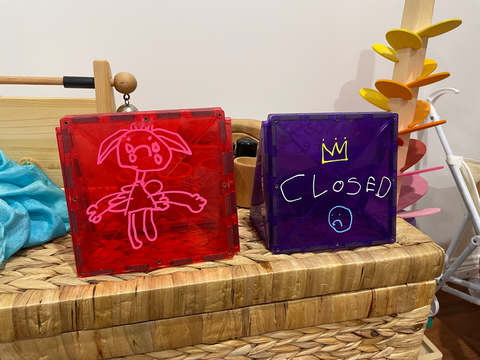
I have curated some ideas of what you can offer at home if your child asks for literacy-based activities. Below you will find the activities for the element 'writing'.
Writing
Writing

Goal: Your child composes emergent texts for specific purposes.
Goal: Your child composes emergent texts for specific purposes.
Activity 2: Ask your child to create signs and labels for their play setups. An open/closed sign for their shop. Or receipts for the purchases in the café. Use various materials such as chalk, wooden line stencils, and letter stamps. By using the Kitpas chalkboard or Create n' Play Wooden Disks, you can reuse the same sign over and over again.

Activity 3: Start a diary or journal that you use for daily entries. This is a great way to end the day and both a great way to implement some mindfulness and reflection as well as writing. Make it a habit for the whole family to spend 10 minutes after dinner writing about their day. My tip would be to use a loose-leaf book, so pages that aren't making the cut can quickly be removed. Adding the magic pen, 4 colour rainbow pencils, and glitter markers guarantee a beautiful daily entry that will be a pleasure to read for years to come.
Goal: Your child identifies written symbols/letters and writes recognisable letters
Goal: Your child identifies written symbols/letters and writes recognisable letters
Activity 1: Play back-drawing. This one is a great activity for beginning writers. I still remember doing this with my mum when we were young. Sit with your back towards your child and ask them to 'write' a letter with a finger on your back. Can you guess the letter they wrote? Take turns in writing and guessing.
You can make this activity more challenging to move to words. Or include the whole family and create 'written' Telephone Game.
Activity 2: Hide the Write and Wipe Letters. You can place them in a sensory base such as rice and hide them under a play silk or in an empty box (we love seeing our cardboard boxes being used again!). Pull out a letter; the person who can think of a word the first gets the letter. They will then trace the letter to get their point. Who can get the most points? This is not only a fun activity to practice letter formation but also great for vocabulary building. You can make it more challenging by adding a specific theme to the words: verbs, animals, things around the house, etc.
Activity 3: Play 4 in a row with the Lowercase or Uppercase Magnatab and Wooden Alphabet Dots. Place the Alphadots on the table. Take turns choosing a letter. Say the sound of the letter and think of a word starting with the letter. Then trace the letter on the Magnatab. Place your coin on top of the traced letter, so you know you claimed it (one person uses lower-case and one upper-case) Who gets 4 in a row first?

Don't have the Magnatab? You can print the foundation font at home, you can download it for free, and it is called Foundation outline arrows, or Foundation Outline Only. It looks like this:

Goal: Your child can write their own name and personally significant words (family names, dog, etc.)
Activity 1: Learn to write with the Magnacrylic educational board. This is a magnetised acrylic wipe clean board. These boards come complete with 8 educational activity pages, including Uppercase Alphabet, Lowercase Alphabet, Pre-writing practise, Blank dotted thirds, and CVC words. However, as mentioned above, it is very easy to print your own words using foundation font. They can focus on learning to write their name by printing your own sheets. Most kids love writing their name, and by using the board, you're not going through 30 pages of paper each day.
We love combining the board with the Life of Colour chalk markers or Kitpas crayons.

Activity 2: A good old favourite of many is the Sight Word Board. This board is used to say, make and write familiar words. The "say' section is made with letter~ or sight word coins. Or – you could cut out the words or letters you printed above.
The 'make' section could be made with anything you can think of. Playdough, gemstones, glitter stones, or even pieces of painted paper. And the last section is where they will write. By using chalk markers, whiteboard markers, or Kitpas crayons, you can use this board repeatedly.


Activity 3: Play 'guess the word'. Create an incomplete word using the Alphabet Coins, Hundreds board and letter coins or Write and Wipe letters. (for example: d_g) ask your child to guess the missing letter. How many guesses did they need? Once they have guessed the word trace the letters and change turns.


Learning to write works best when it is child-led. Pressuring a child who isn't ready is often counterproductive. Letting them take the lead and make writing exciting and fun is best.
This was the last part of our Early literacy blog. I hope you enjoyed it and have learnt something new. I can't wait to see all your play ideas come to life!



